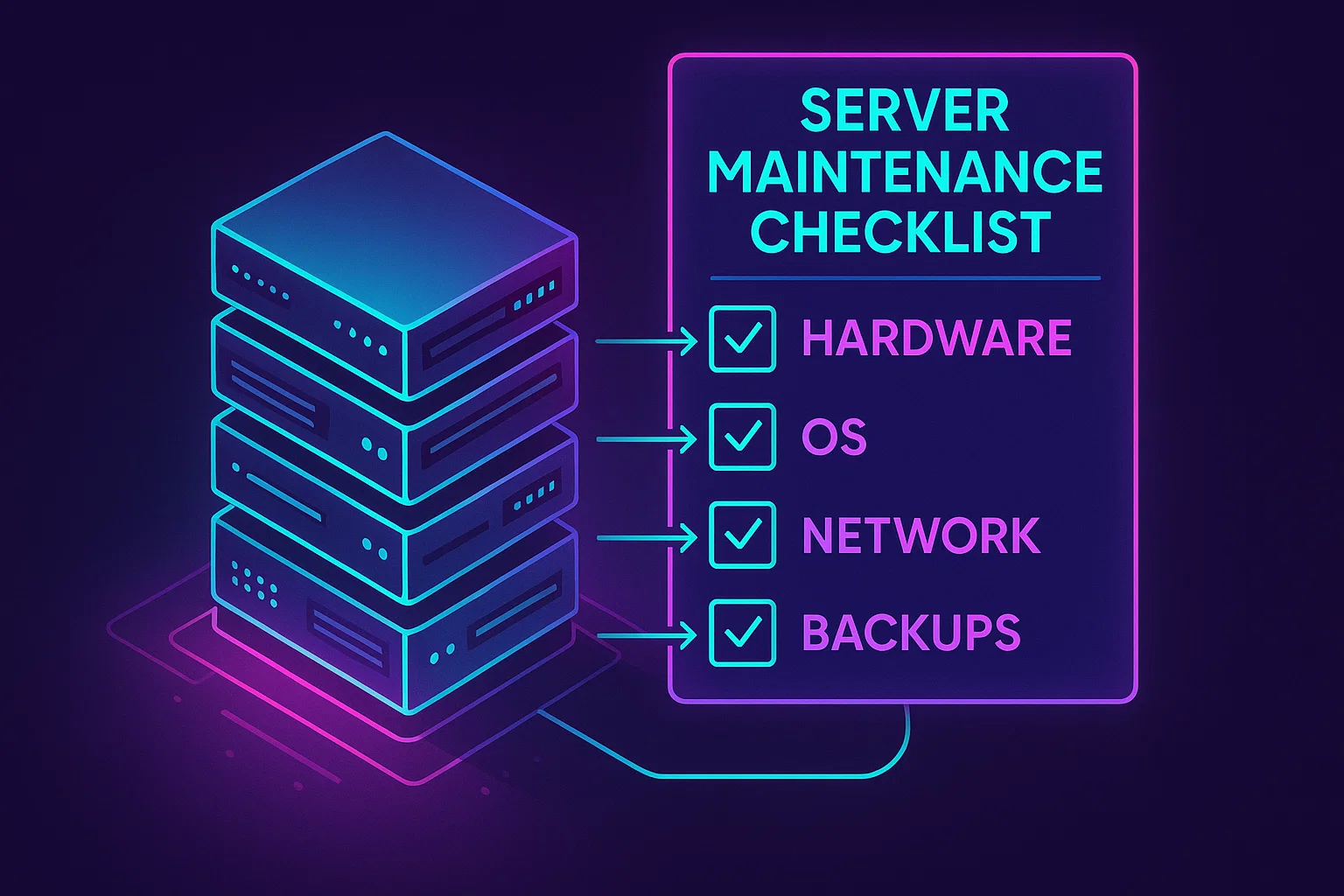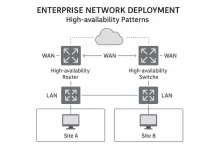Server maintenance checklist—three little words that decide whether your weekend is spent sipping cold brew or firefighting a 3 a.m. outage. I learned that lesson the hard way when a rogue power supply fried half a rack and my pager went berserk. Ever since, I’ve lived by an obsessive, ever-growing list of sanity-saving tasks. Today, I’m sharing the beefed-up version: 25 epic steps split across hardware, software, security, and everything between.

Hardware Health First
Your servers are glorified space heaters unless you treat the metal right. My server maintenance checklist starts with:
- Dust & airflow patrol: Crack the chassis, blast out lint, confirm every fan spins like a fidget spinner.
- Power sanity: Verify dual PSUs have no alarming voltage deltas; cross-check UPS runtime and battery age.
- SMART scans: Run
smartctl -a /dev/sdXweekly; replace disks reporting anything besides “OK”. - Thermal audit: Keep rack temps 18 – 25 °C; alert at 27 °C—your SSD write cache melts above that.
- RAID scrubs: Schedule monthly parity checks; silent bit rot is real.
- Physical security: Locked racks, camera coverage, zero tailgating—because social engineering beats SSH brute force every day.
Operating-System Reality Check
Ignore the OS layer and you’ll watch load averages skyrocket while users rant. Here’s how the server maintenance checklist tames kernels:
- CPU load guardrails: Alert at 80 % sustained usage. If you see
loadavg > cores×2, something’s stuck in uninterruptible I/O hell. - Memory leak hunt: Use
free -h,vmstat 1 5, andsmemto catch runaway Java monsters. - Filesystem feng-shui: Keep /var below 70 %; logs explode overnight.
- Patch discipline: Automate security updates but stage kernel upgrades—nothing wrecks uptime like an unexpected kexec.
- Service watchdogs: Systemd
Restart=on-failurewith sensibleStartLimitIntervalSecprotects against flapping daemons.
Need a refresher on bullet-proof backups before patching? Scan our Windows 11 System Backup guide—cross-platform concepts apply.
Network & Security Fortification
The internet is a bar fight—your firewall is the bouncer. My server maintenance checklist calls for:
- Bandwidth + latency graphs: Zabbix or Grafana shows traffic spikes before latency kills SLAs.
- Port hygiene: Listeners limited to business need; everything else drop-kicked by
firewalld. - TLS audit: Replace certs at 60-day mark; automate via ACME and cron.
- Vulnerability sweeps: Weekly OpenVAS scans; fix high-severity issues inside 72 hours.
- Time sync sanity: Chrony with hardware timestamping ensures your logs testify in court.
- Intrusion alarms: Suricata rules feeding Slack; if China Telecom pings port 3389, I know instantly.
For an extra security layer, roll out two-factor SSH like in our SSH 2FA tutorial.
Backup & Disaster-Recovery Drills
Backups are boring—until they’re thrilling. The server maintenance checklist mandates:
| Cadence | Type | Location | Test |
|---|---|---|---|
| Daily | Incremental | Local NAS | Verify checksum |
| Weekly | Full image | Off-site cloud | Sandbox restore |
| Quarterly | Cold storage | Encrypted drive in safe | Boot & smoke test |
Once a quarter, we simulate “datacenter meteor strike”; spin up from backups in a separate region and run production smoke tests.
Want vendor-neutral best practices? Peek a CIS Linux Benchmarks for cross-checks.
Performance Tuning & Capacity Planning
Slow is the new down. Keep users stoked by baking these into your server maintenance checklist:
- Load balancer sanity: HAProxy metrics—
qcurshould never exceed half ofmaxconn. - Cache hit nirvana: Redis > 90 % hit ratio or you’re overfetching.
- DB slow-query triage: Rotate
slow_query_log, index what hurts, paginate heavy reads. - Horizontal headroom: Auto-scale groups pegged at < 60 % average utilisation during peak week.
- Capacity forecast: Use Holt-Winters to predict CPU growth; order hardware three months early—supply chains bite.
# quick CPU saturation check
sar -P ALL 1 5 | awk '$2 ~ /all/ {cpu=100-$9} END {print cpu"% average CPU used"}'
User & Access Governance
Humans break things faster than rootkits. The unsexy but vital server maintenance checklist items:
- Quarterly review of sudoers; every line needs a justification.
- Expire dormant accounts at 30 days; cron job handles the purge.
- Rotate SSH keys annually; force ED25519, ditch RSA.
- Audit logs via
goaccess; alert on logins outside geo-fence. - Implement Just-in-Time access for production databases—tokens expire in 2 hours.

Documentation & Automation Culture
The finest server maintenance checklist rots if it lives only in someone’s brain.
- Runbook heaven: Every step captured in Markdown, versioned in Git.
- Change logs: Git tags per production push; rollback instructions front-and-center.
- Infra as Code: Terraform + Ansible so rebuilding a server is push-button dull.
- ChatOps glue: A Slack slash-command spits last night’s backup hash because copy-pasting from terminals is so 2010.
Final Thoughts
Print this server maintenance checklist, tape it above the coffee machine, and watch mean-time-to-panic plummet. Remember, uptime isn’t magic—it’s relentless, sometimes tedious vigilance. Get the basics right, automate the rest, and future-you will binge-watch sci-fi instead of chasing kernel panics.

 FoxDoo Technology
FoxDoo Technology







